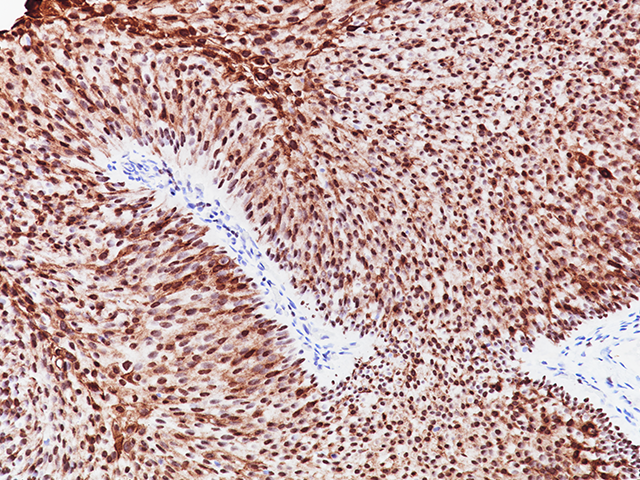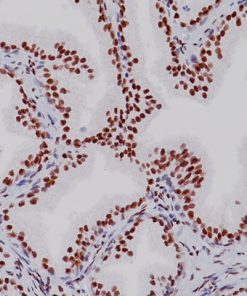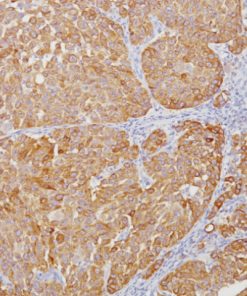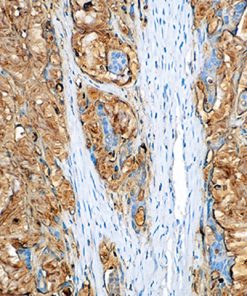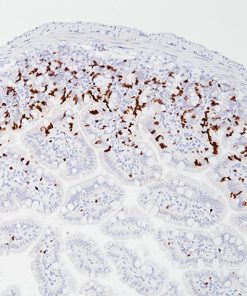GATA-3 + Uroplakin II
$899.00 – $1,080.00
Description
Product Description
Distinguishing between invasive urothelial carcinoma (UC) from other genitourinary malignancies, such as prostatic and renal carcinomas, can be difficult. Several new markers such as GATA binding protein 3 (GATA-3), S100P, and uroplakin III have been developed for this differentiation (1-7). More recently uroplakin II has been introduced (1-7). GATA-3 is a transcription factor and belongs to a distinct family of tumor suppressor genes. It is involved in human cancer cell growth and differentiation, and plays an important role in cell proliferation and apoptosis. Recent studies have found GATA-3 to be a sensitive and specific marker for UC. The level of GATA-3 expression was seen to be an independent factor predicting cancer recurrence (6,7). Uroplakins are markers of terminally differentiated bladder urothelia. Uroplakin II (UPII) is a newly described sensitive marker for UC (1-5). UPII has been shown to be a more sensitive immunohistochemical (IHC) marker than uroplakin III in UC (1,2). UPII has also been used in the diagnosis for UC using a panel that includes GATA-3 and p40 (4,5). The combination of GATA-3 (nuclear) and UPII (cytoplasmic/membrane) in a single color format increased both specificity and sensitivity in a single section (4,5). UPII has been shown to be virtually 100% specific for UC (1-3). GATA-3 increases the overall specificity when compared to UPII alone and it does not stain prostate adenocarcinoma or renal cell carcinoma (4,5). Thus, two antigens, GATA-3 (nuclear) and UPII (cytoplasmic/membrane), can be recognized and displayed on the same section by a single color format.
Specifications
Specifications
| Format | |
|---|---|
| Volume | |
| Intended Use | |
| Species Reactivity | |
| Isotype | |
| Antigen | |
| Localization |
Datasheet & SDS
| Download Data Sheet |
| Download SDS Sheet |
Browse more documents for this product (IFUs, datasheets, translations, SDS, and more).
References
1. Hoang LL, Tacha DE, Qi W, Yu C, Bremer RE, Chu J, Haas TS, Cheng L. A newly developed uroplakin II antibody with increased sensitivity in urothelial carcinoma of the bladder. Arch Pathol Lab Med. 2014 Jul;138(7):943-9.
2. Tian W, Guner G, Miyamoto H, Cimino-Mathews A, Gonzalez-Roibon N, Argani P, Li X, Sharma R, Subhawong AP, Rezaei K, Bivalacqua TJ, Epstein JI, Bishop JA, Netto GJ. Utility of uroplakin II expression as a marker of urothelial carcinoma. Am J Clin Pathol. 2014 Dec;142(6):864-71.
3. Li W, Liang Y, Deavers MT, Kamat AM, Matin SF, Dinney CP, Czerniak B, Guo CC. Uroplakin II is a more sensitive immunohistochemical marker than uroplakin III in urothelial carcinoma and its variants. Am J Clin Pathol. 2014 Dec;142(6):864-71.
4. Hoang LL, Tacha D, Bremer RE, Haas TS, Cheng L. Uroplakin II (UPII), GATA3, and p40 are Highly Sensitive Markers for the Differential Diagnosis of Invasive Urothelial Carcinoma. Appl Immunohistochem Mol Morphol. 2015 Nov-Dec;23(10):711-6.
5. Leivo MZ, Elson PJ, Tacha DE, Delahunt B, Hansel DE. A combination of p40, GATA-3 and uroplakin II shows utility in the diagnosis and prognosis of muscle-invasive urothelial carcinoma. Pathology. 2016 Oct;48(6):543-9.
6. Mohammed KH, Siddiqui MT, Cohen C. GATA3 immunohistochemical expression in invasive urothelial carcinoma. Urol Oncol. 2016 Oct;34(10):432. May 27.
7. Miyamoto H, Izumi K, Yao JL, Li Y, Yang Q, McMahon LA, Gonzalez- Roibon N, Hicks DG, Tacha D, Netto GJ. GATA binding protein 3 is down-regulated in bladder cancer yet strong expression is an independent predictor of poor prognosis in invasive tumor. Hum Pathol. 2012 Nov;43(11):2033-40.
8. Center for Disease Control Manual. Guide: Safety Management, NO. CDC-22, Atlanta, GA. April 30, 1976 “Decontamination of Laboratory Sink Drains to Remove Azide Salts.”
9. Clinical and Laboratory Standards Institute (CLSI). Protection of Laboratory Workers from Occupationally Acquired Infections; Approved Guideline-Fourth Edition CLSI document M29-A4 Wayne, PA 2014.
Related products
Primary Antibodies


